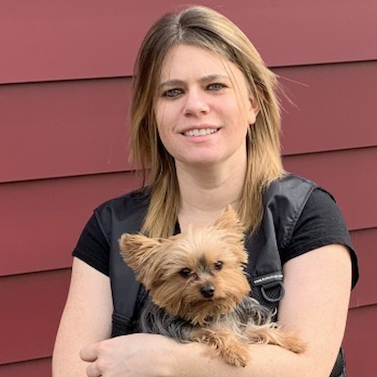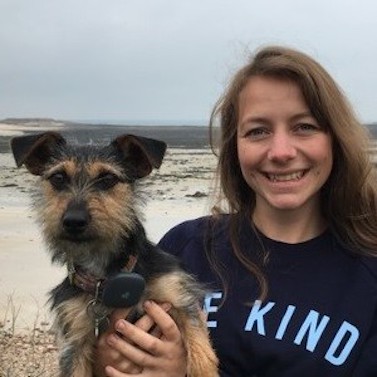Dogs need physical activity to stay healthy and happy, so what do you do if they sustain an injury that makes exercise painful or downright impossible? Or if they have a condition such as diabetes, heart disease or anemia? We asked dog experts to share tips to help you keep your pet fit in spite of physical limitations. Read on to learn more.

Colby Lehew is a Canine Massage Therapist and Dog Sports Trainer based in Chicagoland. Find her at dogletics.org.
Table of Contents
Canine massage therapy
The best way to exercise a dog that has an injury or a limiting condition depends on the extent of the injury. If the injury is localized the dog may be able to participate in canine fitness, which is like yoga for dogs. Be sure to select exercises that do not put weight on the injury. Consult your vet before starting an exercise program.
However, dogs that are limited can benefit from canine massage therapy.
First off canine massage therapy works in two ways. The first way is called passive range of motion. Passive range of motion works muscles without weight-bearing.
Range of motion is the action of moving a joint according to its intended function. For example, rotating your arm in a circle would be an active range of motion test for the shoulder joint.
Passive range of motion differs from active range of motion because your muscles are not actively firing. Instead, someone else moves the joint for you. While your muscles are not firing you still get the benefits from movements such as muscle strengthening and lengthening.
To do passive range of motion for your dog, you would put your dog in the lying position. You would stabilize their shoulder, hip, forearm, or leg joint with your non-dominant hand. This means you are to place that hand underneath the joint. For example, when doing the shoulder range of motion exercise, your stabilizer hand would be in the armpit. In the case of the hip joint range of motion activity, your stabilizer hand would be near the groin. Your dominant hand would then hold the joint on the other side.
For ball and socket joints (hip and shoulder) you make circular movements (made with the outside hand). For hinge joints, such as the forearm, you extend and flex the arm. You mustn’t extend, rotate or flex any muscle too quickly. You need to respect your dog’s range of motion limitation. By making soft, slow, and gentle movements your dog will have the ability to inform you that you have gone too far. They will most likely pull the leg or arm away from your hand.
The second thing you can do for your dog is to learn some DIY techniques. Massaging soft tissues brings blood to the muscles and can help prevent atrophy of the muscles. It also supports the healing process. There is even something called lymphatic massage which helps the body filter out expired immune cells. However, that lymphatic technique is too advanced without training.
Brain stimulation and sniffing challenges
The good news is that there are plenty of fantastic indoor exercise options for dogs with injuries. However, you’ll have to rethink the concept of “exercise” a bit. For dogs, brain stimulation and sniffing challenges can be just as energy-burning as a brisk walk!
My first recommendation is to swap out your dog’s food bowl for a puzzle feeder! From the Kong to the Bob-A-Lot, there are tons of fantastic puzzle toys that you can use to feed your dog his entire dinner while making him work a bit and exercise that brain!
Puzzle toys can vary from simple to advanced, with one of the most incredible high-tech options being the PupPod, which will shoot out kibble as your dog completes specific tasks.
Next up are nose work games, which usually involve hiding stinky treats in various containers and having your dog use his sniffer to locate the goodies. Sniffing is incredibly self-soothing and exhausting work for dogs, so nose work games are always an easy win when it comes to burning off excess energy! You don’t even need to buy anything special for many nose work games – you can just use things around the house, like tennis balls and muffin tins!
Alternatively, a good ol’ stinky treat scavenger hunt works great too!
You’ll also want to consider grabbing your pooch some frozen toys and chews to chomp on. Chewing is a natural behavior for dogs and is very satisfying for them – just make sure they are chewing and licking stuff you want them to and not your furniture!

Meg Marrs is the founder of the dog care website K9 of Mine, dedicated to helping owners take the very best care of their four-legged friends.

Dr. Joanna Woodnutt, MRCVS works at DoggieDesigner.com.
Adapt a routine that suits him
If your dog has recently undergone surgery or has a condition that prevents him from exercising as normal, you need to adapt your routine to suit him. Talk to your vet about the appropriate amount of exercise for his condition.
For instance, arthritic dogs still need exercise, but this should be short walks, little and often, with no running or ball-chasing. For dogs post-surgery or in a cast, though, they can be on restricted exercise for 6+ weeks, which can make life really difficult. Again, your vet will be able to give you the exact details of the amount of allowed exercise. However, it’s important to remember a few things:
Reduce his calories
As soon as he stops exercising, his calorie needs will reduce. And gaining weight at this point will not be helpful! Make sure you reduce his calories to account for the lack of exercise.
He needs mental stimulation
A walk isn’t just physical exercise, it’s mental exercise too. All those sights, sounds, and smells give your dog’s brain something to do. When a dog is on restricted exercise, they quickly become bored. Try using puzzle feeders, dog TV, and ‘sniffaris’ to give your dog something else to think about.
Consider physio or hydrotherapy
Your dog might not be allowed to go running around the park, but some exercise is still good for them. Talk to your vet about whether hydrotherapy is useful. If not, they may be able to recommend some home-physio exercises you can do with your dog.
